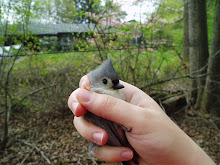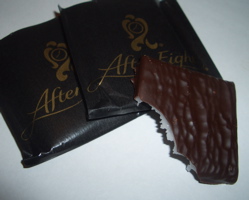Flipping through bridal magazines, you see many cakes. A majority of them, at least the über-fancy ones, are covered in fondant. Fondant (for those of you not shopping for pastry at the moment) is what makes cakes look like this:
A cake frosted with buttercream, on the other hand, looks more like this:
Both cakes look lovely, but notice how the top cake is so smooth and sculptural, while the bottom one (which in my opinion looks more delicious anyway) is a little rougher; there are little air bubbles and minor imperfections along the sides, the lines aren't quite perfect.
"What the heck does this have to do with science? I didn't come to this site to read about fondant vs. buttercream! I demand an explanation!"
Let's start out just talking about fondant. Fondant is a heavy paste which, at its most basic, is made with just water, sugar, a little food coloring, and a skilled hand. (A candy thermometer helps, and there are many variations using different sugar ingredients.) If you accidentally jolt the bowl while it's cooling, the sugar will come out of solution quickly and in large crystals; presto, rock candy!
However, by mixing the water and sugar together at a high temperature and then cooling it very gently, stirring violently at the very end, the supersaturated solution forms very tiny crystals that look as smooth as a lake on a calm day. You can use this paste to decorate cakes in myriad ways -- a quick Google images search for fondant cakes will give you an idea of just how many! You can sculpt with it. You can cut it and shape it. And, for all intents and purposes, you can even eat it. (Although not that many people do.)
Now, if you made fondant from scratch, you would likely just use sucrose -- that is, ordinary table sugar.
And if you cut that piece of fondant into squares and dipped them into chocolate, you would have this:
"But wait! The inside of an After Eight mint is so creamy and soft! There's no way it could be the same as that stiff piece of fondant covering the cake up there!"
Ah. Yes. You have a point.
And that is where the enzymes come in. Invertase is a naturally-occurring enzyme produced by some bacteria as well as some animals that breaks down sucrose into its component sugars, glucose and fructose, which is sometimes known as inverted sugar syrup. (The reason for "invert" is interesting but I can't explain it well; read about it here.)
In the production of After Eight mints, a small amount of invertase is added to the minty fondant just before it is coated with chocolate. The enzyme doesn't begin to work immediately, so the chocolate can cool around the fondant before it begins to "cure". The smaller, more soluble molecules of glucose and fructose go into solution more readily and disolve in the small amount of water contained in the fondant; it isn't enough to create a runny liquid, but it's enough that when you bite into an After Eight (or any other fondant-filled treat) the texture is creamy and viscous and not a stiff paste.
Mmm, enzymes. What can't they do?
PS: On a totally unrelated note, we just watched the first segment of Dr. Horrible's Sing-Along Blog. Hilarious! So much fun! Go watch while you can, it's gone on Sunday.
Subscribe to:
Post Comments (Atom)






3 comments:
FAYE. I love your blog. Just sayin'.
:D
thanks!
"Invert" wrt (with respect to)sugar refers to the way the solution bends polarized light...As the Sucrose breaks (by enzyme) to glucose and fructose, the pattern of the light is flipped about, or "inverts." The "inverted syrup" is sweeter as there are more free sugar molecules (2:1) compared to sucrose alone. Daddy-O
Post a Comment